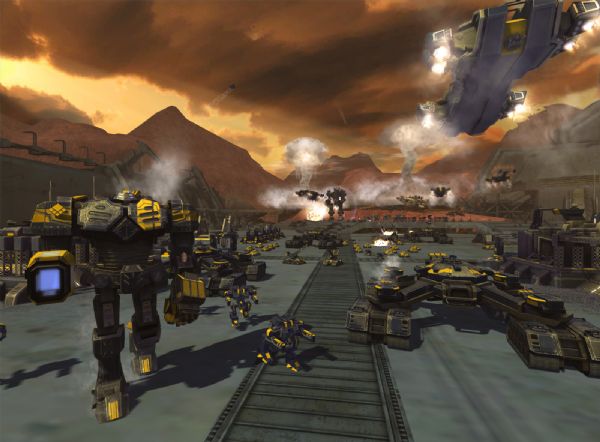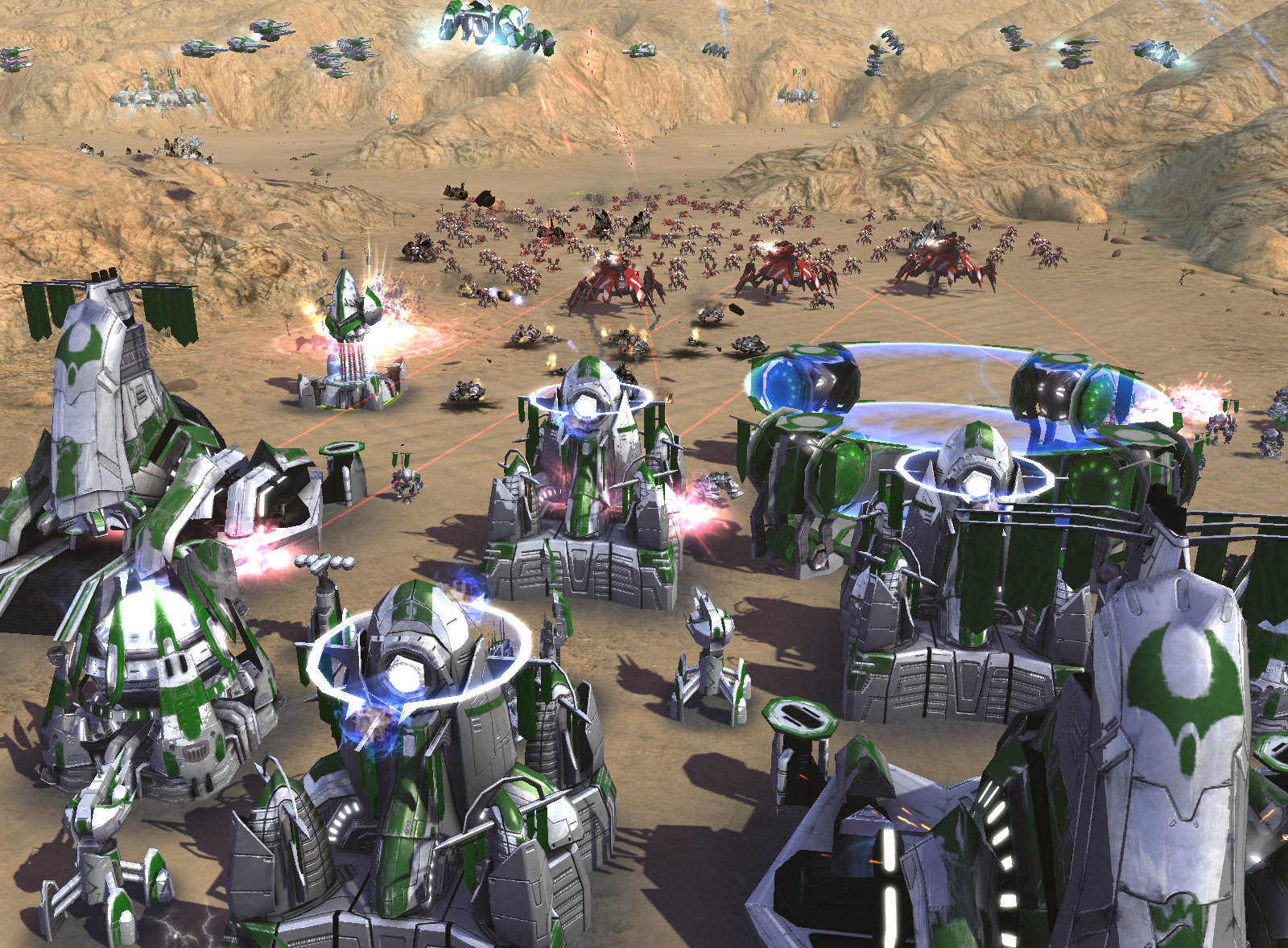I never had the opportunity to play the first Supreme Commander. It was released at a time when I still had a sub-par gaming PC and didn’t have the resources to run it. All I could do was stare at the game, read up on it, and yearn to play it. It is, after all, Chris Taylor’s spiritual successor to Total Annihilation, a game I remember fondly and still find to be just as enjoyable as the first time I played it. That being said, I was delighted when Supreme Commander 2 showed up in my inbox and I would finally be able to play the massive RTS that the series is known for so far.
After spending some time with the game, though, I may want to try the first one instead.
Supreme Commander 2 is a vastly different experience than its predecessor. And it’s a puzzling change to say the least. The first game was lauded for its massive battles and an intense focus on multiple war fronts. For the sequel, developer Gas Powered Games decided to draw all this back and make a tighter and more compact title, streamlining most of the RTS minutiae and producing a game that is quicker and simpler than your standard RTS. It’s a smart move in some respects, but they stripped a bit too much, leaving something that feels very bare.
Supreme Commander 2 takes place 25 years after the events of Supreme Commander: Forged Alliance. The treaty that was signed at the end of the expansion has broken down due to an assassination of a prominent world leader, and the three main factions are at war once again, each trying to prove they were not part of the plot. As your progress through the campaign, you will take control of three commanders from each faction: the UEF, Aeon Illuminate, and the Cybran Nation. The main campaign consists of 18 missions, 6 for each faction, and will take you through some pretty enjoyable scenarios. It’s important that the missions be somewhat entertaining, because the game’s story alone is not going to drive you through the single-player campaign. The plot is paper thin, likewise populated with shallow characters and lame melodrama. There is no real conflict, or it isn’t conveyed well enough, and I was constantly bored by whatever the characters were spouting. Nothing made sense and the game never bothers to bring you up to speed on what is happening. It just assumes you’ve played the first game and actually care about what is going on.

At least the combat and missions provide some fun. The game dials back the grand stage of war from the first game and what you get are smaller battlefields and tighter combat. Instead of having a ton of different units, each with a specific purpose, Supreme Commander 2 sports only a few select units that each building can produce. While this may sound like a turnoff, it’s nice having a smaller unit selection and not being overwhelmed with a few dozen different units that have to be used in a certain manner. The same goes for buildings; there are only a few different factories or resource centers to be built and most have numerous uses that will cover most of your needs. It’s a nice system that promotes more attention to your strategy and crushing your opponent, and less time trying to micromanage all of your units and economy.
The way the game gets around having a “base” army is through the research trees. As you participate in battle and build Research Silos, you accrue Research Points. These points can be used to pour into your tech trees. There are 5 tech trees — Air, Naval, Land, Structure, ACU — and where you invest your points determines your focus during the mission. Do you want to focus on land, upgrading your tanks to add more firepower and anti-air capabilities? Or do you want to take to the air, delivering precise bombing runs and effective air-to-air combat? Your units and buildings will change as you research new upgrades, so a fully upgraded tank will look vastly different than a base tank. It’s a neat way to add depth without having to add needless units and buildings.

The main issue that pops up with this system is that the developers pulled back too much. While the gameplay is solid and simple fun, the feature set of the game is bare bones. Each faction is almost indistinguishable from the others, save for a few minor differences in appearance, higher-tier units, and their experimental units (high-end units that can turn the tide of battle). The campaign can be completed in about 6-7 hours, and it would have been better to spend more time with each faction than just six missions. There is a skirmish mode for you to take on the computer, but the main draw, multiplayer, is a huge disappointment. There are three game modes present, Assassination, Supremacy, and Infinite War, and a decent amount of maps to wage war on. The problem is that there is no system to find games, match you to opponents of a similar skill, and most importantly, no ranking system of any sort. You basically have to choose a room and hope it’s what the description says (and then that they guy won’t quit out without penalty). Winning matches gives you nothing, so you have no real incentive to play, or take the chance of playing, only to have your opponent rage quit before you enter his base. In an age when games sport experience systems or ranks to be earned, this is a huge misstep, especially in a title that features a player controller avatar in the ACU unit. Gas Powered Games could have made your multiplayer ACU upgradable from winning games or let you customize it with emblems or ranks, making it persistent. With Command and Conquer 4 hot on your heels and armed with a persistent ranking system, you have to offer something to keep your players engaged. Supreme Commander 2 fails there.
Technically, however, Supreme Commander 2 looks and sounds great. The maps you fight on run the gamut from bare to beautiful. Some will be highly detailed and others are bare desert or on plains. Faction buildings are nicely detailed and are fully animated as they produce your army. Experimental factories are a real treat, illustrating the entire process of building your giant war machines from scratch. There is a level of anticipation watching these factories construct your experimental units that is fully matched when they appear and roll out. The sound effects compliment this well, with booming artillery shelling your foes or bombers letting loose their cargo with deafaning explosions. Drop a nuke on your enemy and the resulting visual feast both looks and sounds powerful.
Supreme Commander 2 feels like Gas Powered Games was trying to make a game that appeals to all audiences, but pleases none. The simple RTS gameplay can be too bare bones to PC RTS purists and RTS newcomers will find that the tech trees to be overwhelming. I see that there is an Xbox 360 port coming out a week after the PC release and it seems clear that they tried to make a game that would translate well to the console, unlike the first game’s disastrous port. The game is trying to straddle the line between two worlds and it can’t quite keep its balance. If you are looking for a more robust game, I would wait for C&C4, but if you like the Supreme Commander franchise or are looking for something a bit simpler than your standard RTS, then this game can satisfy the craving.

















